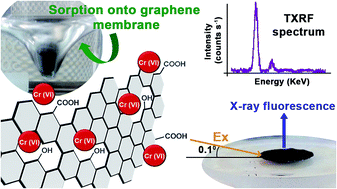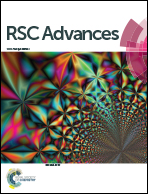Graphene membranes as novel preconcentration platforms for chromium speciation by total reflection X-ray fluorescence†
Abstract
Fabrication of unmodified graphene membranes for their application as selective sorptive platforms of hexavalent chromium [Cr(VI)] is described for the first time. Multilayer graphene membranes are synthesized by drop-casting of graphene oxide (GO) onto a glass substrate followed by mild thermal reduction. As-prepared membranes are formatted to fit the measurement area of total reflection X-ray fluorescence (TXRF). Structural and morphological characterization by atomic force microscopy (AFM) and X-ray photoelectron spectroscopy (XPS) shows that graphene membranes are 122 nm height and contain non-reduced functional groups resulting in lattice defects. Adsorption isotherm models and characterization by time-of-flight secondary ion mass spectrometry (TOF-SIMS) indicate that adsorption sites on graphene membranes are uniformly distributed and bind Cr(VI) as a monolayer, both by electrostatic interaction and chemisorption. Graphene membranes display high flexibility and become conical-shaped when immersed into stirred liquid samples. When combining graphene membrane preconcentration and TXRF, a detection limit of 0.08 μg L−1 Cr(VI) is obtained. Repeatability expressed as relative standard deviation is 3% (N = 5). Two certified reference materials, i.e. CASS-4 seawater and NWTM-27.2 lake water, are used for testing accuracy. The proposed method is simple, solvent-free and sensitive, being suitable for Cr speciation in water including high salinity samples.


 Please wait while we load your content...
Please wait while we load your content...